The thicketing plums in full bloom–this thicket began with a few stems of plum stuck in the ground.
This tiny fly is one of many flies and bees working on the plum flowers today.
Scarlet Buckeye flower bud showing between the barely-opening leaves. We have both the Scarlet (which is actually a deep dusty red-rose) and a pink-flowering one, both native to Central Texas. They’re sun-sensitive and the leaves “burn” and fall off by early summer.
The Scarlet Buckeye leaves are elegantly pleated when they first open.
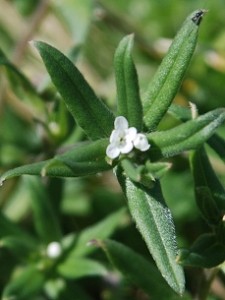 Although these flowers are tiny, their clean white shows up well against the dark green leaves.
Although these flowers are tiny, their clean white shows up well against the dark green leaves.
Just as tiny are these little blue flowers that appear singly and scattered over the low-growing plants–one of the speedwells.
Out in the east grass, we flushed a lot of sparrows from the grass, but most were too fast and made it to good cover before we could photograph them. This one, however, perched up in an osage orange tree and let me get close enough. It was hard to see against the gray-white sky (even with binoculars, I could see only that it had a streaked breast–the rest was silhouette.) The camera, however, performed well…it’s a Savannah Sparrow.
Back in the yard, we sat outside and watched birds at the feeder and the artificial stream. This male House Finch was a slightly different shade of red from the first to appear; we’ve had three pairs around for over a month, all redder than our usual ones.
Finally–the most vividly colored of our anemones (and quite rare) is the deep purple one. White is the commonest, pale pink or shades of pale blue come next–but this one, I wish I had an acre of.
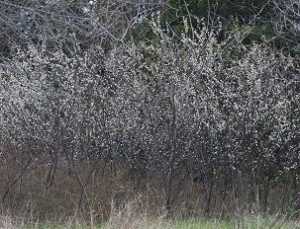
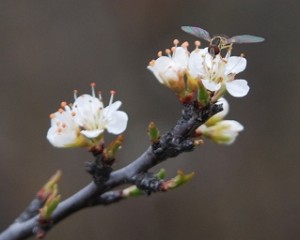
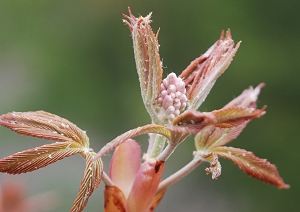
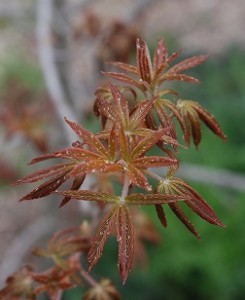
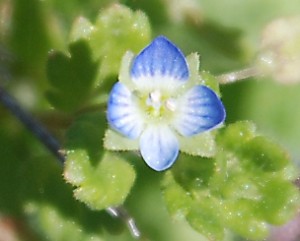
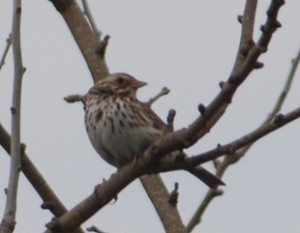
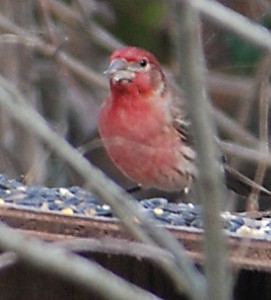
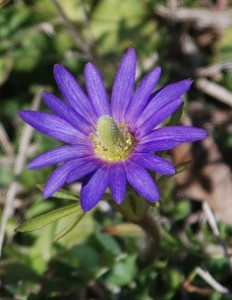
Comment by cdozo — March 7, 2010 @ 12:28 am
So pretty!
Comment by AnnMCN — March 7, 2010 @ 7:27 am
I applaud your bird recognition skills! Finches and sparrows make me nuts. A good camera and the reflexes to use it must be a huge help.
Comment by Joy K. — March 7, 2010 @ 8:26 am
I’m with AnnMCN. Little Sparrowy Things (LSTs) and Little Finchy Things (LFTs)!! I love them, but the frustration they bring on is intense.
Comment by elizabeth — March 7, 2010 @ 5:55 pm
The cameras have helped a lot, Ann. Sparrows…little brown streaky birds–finally yielded to two winters of study at their watering site out on the land, where I also spread some food under leafless elbowbush (they felt secure under the branches, but I could see through them.) Binoculars and camera and Sibley’s book by my side. I can still confuse Vesper and Savannah without a photograph to blow up and look at the details. Saw and photographed Le Conte’s for the first time this year.
If you can lure sparrows in close enough, often enough, long enough…suddenly they begin to make sense. I started with the dead-easy White Crowned and slowly (and it was slow) worked my way along from there. We have up to twelve species wintering here (usually more like 7 or 8) and that’s been a great learning experience.
Comment by elizabeth — March 7, 2010 @ 5:59 pm
The only way I know to learn the little dickenses is to spend hours with binocs (and camera, if you can) at a location where you can tempt them fairly close with food and water. I never used a blind, and “our” sparrows usually took 20 minutes to come to feed after I put it out (though after awhile, one dry winter, the white-crowned sparrows–the boldest in winter quarters–would start calling as soon as I got to the dry woods and sort of follow me up to the place where I put feed out–we also have a wildlife guzzler there.